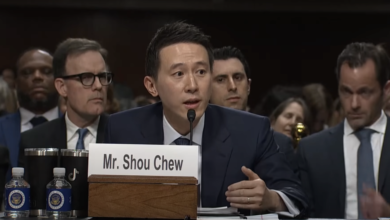In 1994, war between the United States and North Korea was narrowly averted by a high-level diplomatic effort undertaken by former U.S. President Jimmy Carter. Carter held face-to face talks with North Korean President Kim Il Sung.
Twelve years later, there is a new confrontation with North Korea. The stakes are high. While none of the major players want an open military conflict, the stage has been set for a possible naval blockade of North Korea. A blockade is a move that the government in Pyongyang has said it will greet as an “act of war.”

South Koreans protest Condoleezza Rice’s visit to Seoul, Oct. 18. |
China and South Korea are looking for a negotiated settlement along the lines of the 1994 General Framework Agreement. Both governments recognize that it was the U.S. government that killed the agreement. Inside the U.S. government, there may be voices that fear a rapid escalation of the crisis, but the general tenor of the Bush administration is provocative, threatening and aggressive. Its goal is to overthrow the government of North Korea.
Looking back to the 1994 crisis: ‘the almost war’
In 1994, the Clinton administration was on the verge of initiating military action against North Korea. The issue then was North Korea’s plan to develop nuclear power as a new energy source.
Instead of the crisis escalating into a full scale war, the two sides signed the General Framework Agreement. Korea agreed to suspend and freeze its program to construct “heavy water” nuclear energy reactors in exchange for the U.S. agreeing to finance and construct light water nuclear reactors.
North Korea, which had experienced a catastrophic loss of energy supplies with the collapse of its socialist allies in the Soviet Union and Eastern Europe from 1989 to 1991, desperately sought a replacement source and to meet other energy needs.
The U.S. government agreed to finance and construct light water reactors. This technology does not produce the plutonium byproduct or waste that could be enriched and used for the creation of nuclear weapons. It also agreed that it would normalize diplomatic relations and end economic sanctions on Democratic Peoples Republic of Korea, the official name of North Korea.
Although North Korea lived up to its side of the General Framework Agreement, the United States did not.
Eight years passed before the United States took even the first steps to begin constructing the light water reactors. Lacking energy sources, North Korea’s agricultural system nearly collapsed. It is country with a climate plagued by a rugged, rocky and mountainous landscape. Only 15 percent of the land in North Korea is arable. The absence of energy sources was a kind of death sentence. The U.S. government was using food as a weapon.
North Korea was supposed to collapse, according to the estimates of the policy makers in Washington, D.C., the Pentagon and on Wall Street. But the government survived. Its resilience opened a short-lived shift in U.S. policy.
In the final years of the Clinton administration, the U.S. government began moving back toward the promise of the 1994 General Framework Agreement. The president of North and South Korea held a historic summit in June 2000 in Pyongyang to announce a new era of peaceful cooperation. Given that the South Korean government was largely a U.S. client regime, the summit and the thaw in relations between the south and north was hardly conceivable without an explicit green light from the White House.
Clinton dispatched then-Secretary of State Madeleine Albright to North Korea. Her meetings with North Korean leaders were the highest-level diplomatic talks between the United States and North Korea in over 50 years. It appeared as if the ongoing 50-year-long war—the United States has never signed a formal peace treaty ending the 1950-53 Korean War—was finally giving way to normal diplomatic relations.

Facing the “axis of evil.” North Korean soliders talk in the town of Sinuiju. |
The Clinton administration, like all U.S. governments, embraced the need to overthrow the government in North Korea. But having been frustrated by the efforts to do so through force, Clinton was opting for a different road. His administration was hoping for what might be called the “peaceful transition back to capitalism.”
Bush White House changes strategy
Then, in 2002, George W. Bush used his state of the union address to label North Korea as part of the so-called axis of evil, along with Iraq and Iran. Instead of normalizing relations with North Korea and lifting economic sanctions, North Korea was explicitly targeted for “regime change.”
Bush’s open bellicosity and threats led North Korea to unfreeze its nuclear program, expel inspectors from the International Atomic Energy Agency and announce that it would pursue developing nuclear weapons as a legitimate form of self-defense.
North Korea, like the entire world, knows that the U.S. government possesses 16,000 nuclear weapons and has adopted a nuclear first-strike option against North Korea as part of its official operational strategy. Click here to read the National Security Strategy of the United States 2002.
Maintaining a monopoly or near monopoly on nuclear weapons in northeast Asia was long considered a central foreign policy objective of the United States. The U.S. views northeast Asia as a pivot in its scheme for regional and world domination.
If North Korea develops nuclear weapons, the U.S. government fears that the “hard-line” nationalist sectors within the Japanese military and political establishment will insist on overcoming their ban on nuclear weapons. As a highly developed imperialist country, Japan could rapidly build a very large nuclear arsenal. This is a great fear for U.S. imperialism, which has maintained Japan as a junior partner since the end of World War II.
The natural tendency toward competition and rivalry between capitalist powers has been muted since the close of World War II. This has given the United States a huge advantage throughout Asia.
The quid pro quo since Japan’s unconditional surrender in 1945 was that the United States would be the protector of Japan’s military interests; in return, Japan would be given free access to regional and world markets for its products. As a result, the United States has exercised global and regional hegemony with Japan functioning as a junior partner. This arrangement is now in jeopardy.
It was no accident that U.S. Secretary of State Condoleezza Rice’s first visit since the onset of this new crisis was to Japan. She arrived on Oct. 18.
An Oct. 19 Associated Press dispatch about Rice’s visit made it clear that the U.S. government fears a new alignment in Asia if Japan becomes an independent nuclear power. “While visiting Tokyo on Wednesday, Rice said the U.S. was willing to use its full military might to defend Japan in light of the North’s nuclear test. She also sought to assure Asian countries there is no need to jump into a nuclear arms race.
“Japanese Foreign Minister Taro Aso drew a firm line against his nation developing a nuclear bomb, after he met with Rice on Wednesday in Tokyo.

A meeting of the imperialist minds. Rice with Japanese Prime Minister Shinzo Abe in Tokyo. |
“Rice also reaffirmed U.S. President George W. Bush’s pledge, made hours after North Korea’s underground test blast, “that the United States has the will and the capability to meet the full range—and I underscore the full range—of its deterrent and security commitments to Japan.”
Seeking nuclear primacy
When the United States enjoyed a complete monopoly of nuclear weapons, it did not hesitate to use these weapons against its adversary. The destruction in August 1945 of two non-military Japanese cities, Hiroshima and Nagasaki, with only two solitary bombs was the dramatic inauguration of the period of nuclear diplomacy.
The rise of the Soviet Union as a nuclear power in the early 1950s was deeply upsetting to the military and civilian leaders of U.S. imperialism. It negated the ultimate military and diplomatic power of the U.S. nuclear arsenal. If either side used these weapons, their mutual destruction would be assured.
Now that the Soviet Union and most of the socialist governments have been overthrown, the relationship of forces in the world has shifted to the advantage of the United States in its endless exercise and aspiration for global empire.
The United States, as evidenced by its invasion of Iraq and destruction of its government, wants absolute power. It wants to crush those who seek independence, or even neutrality, from the U.S. empire. The idea that North Korea could develop nuclear weapons is a sign that resistance to Washington’s plans by formerly colonized countries is possible.
This runs contrary to the strategic planning of the Pentagon and the White House. Their goal in the next decade is to retake the position of U.S. nuclear primacy, a position they enjoyed from 1945 to 1950 and then lost as a consequence of the rise of Soviet military power.
The policy makers in Washington want to go back to these “good old days.” All people who fear the danger of new and even larger military conflict must understand that the origin of the threat emanates not from Pyongyang, but from within the belly of the U.S. military-industrial complex.





